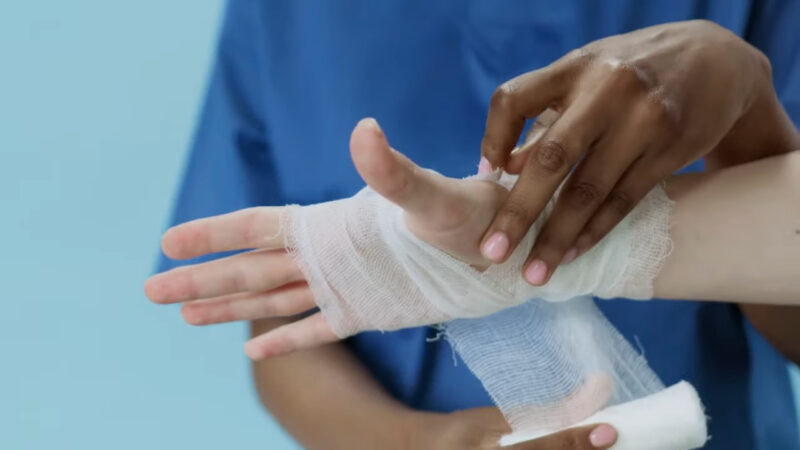Clean gauze, mild solutions, and sterile tweezers are best for cleaning open wounds.
Using the right open wound treatment can mean the difference between quick recovery and prolonged healing, excess scars, intense pain, increased risk of infection, or more. Unfortunately, a number of misconceptions and confusions surround open wound care, mostly due to persistent common wound treatment myths and old wives’ tales.
To help set the record straight and ensure that you will have a favorable healing process, here are some of the right and wrong strategies to use when managing your open wound treatment.
Good Idea: Cleaning the Wound Immediately with Mild Solutions
Infections are caused not only by exposure to bacteria and pathogens, but also from contact with the surface that caused the wound. For example, a tree branch that caused an abrasion could have bacteria on its surface, as could a kitchen knife that caused an skin puncture.
Flush the wound surface and interior as you can with a mild solution. A saline solution made from a small amount of salt diluted in water works well since it mimics your body’s internal pH. You can also use mild or diluted soap in water works well or some purified water, then wipe the surface with clean gauze.
Take notice of any debris that may be lodged in the wound and remove it with sterile tweezers if possible. If the debris is deep or dispersed, you should seek emergency care.
Bad Idea: Using Strong Antiseptics to Wash Wounds
Conventional wisdom suggests using disinfectants and antiseptics like hydrogen peroxide, rubbing alcohol, or iodine to clean open wounds. Most of these substances are better suited for disinfecting household surfaces and are far too harsh for use on human tissue. They are more likely to damage tissue than help it heal.
Good Idea: Applying Pressure
Stopping bleeding quickly can prevent anemia and other conditions that lead to a weakened immune system and slower healing times during open wound treatment. Cover the wound with absorbent material like sterile gauze pads or a clean, dry cloth. Maintain pressure for one to five minutes. If the bleeding does not slow or continues to persist, you will need medical treatment to close the wound.
Good Idea: Keeping Open Wounds Covered and Moist

Medical professionals began to realize the benefits of covered, moist wounds as far back as the early 1960s. At that time, Dr. George D. Winter published a paper revealing, “Wounds that were kept moist healed in approximately 12 to 15 days, while the same wound when exposed to the air healed in about 25 to 30 days.”
Covered, moist wounds transition more quickly into the proliferation phase of wound healing where new skin and tissue begins to grow. Wounds left to “air dry” periodically will form a crust over the epithelializing layer, inhibiting the growth of new granular tissue, slowing healing, and encouraging more scar formation. Dry air can also contribute to cell death in tissues not yet covered by a protective skin layer.
Keep your open wounds covered with advanced wound dressings like films and hydrogels. These products are specifically designed to create moist wound healing environments.
Bad Idea: Ignoring Wounds That Do Not Heal or Worsen Over Time
Most open wound treatments for minor injuries reach the proliferation stage within a period of one to three weeks, meaning the wound is actively healing if being managed through periodic cleanings and dressing changes.
However, wounds that seem persistent will likely have some sort of complication related to the healing process. This can include:
- Excessive inflammation — swelling that affects the region around the wound
- Infection — heat, smells, pain, and other symptoms could indicate infection
- Slowed healing — slow wound progression during open wound treatment can mean any number of problems including autoimmune disease, malnutrition, etc.
If your wound is not healing at a steady rate, it could be infected or complicated by another health condition. Do not ignore the signs; visit a medical professional as soon as possible.
Good Idea: Taking Control of Your Care

Common over-the-counter wound care solutions may not always be capable of meeting your needs. If you have one or more open wounds that are not healing properly, you need to take control of your care and seek medical assistance from a trained professional.
FAQ
1. What should I do if I get something stuck in my wound?
If the object is small and easily removed, you can carefully try to remove it with sterile tweezers. However, if the object is large, deep, or firmly lodged, do not attempt to remove it yourself. Seek medical attention immediately.
2. How often should I change the dressing on my wound?
The frequency of dressing changes will depend on the type of wound and the specific instructions from your doctor. Generally, you should change the dressing whenever it becomes wet or soiled.
3. Can I swim or bathe with an open wound?
It is generally best to avoid swimming or bathing with an open wound, as this can increase the risk of infection. If you must bathe, keep the wound dry with a waterproof bandage.
4. What should I eat to help my wound heal faster?
A healthy diet is important for overall health and wound healing. Make sure to eat plenty of fruits, vegetables, and lean protein.
5. How can I prevent scarring?
While some scarring is inevitable, there are things you can do to minimize it. Keep the wound clean and moist, and avoid picking at it. You can also talk to your doctor about scar-reduction treatments.
Final Words
Proper open wound treatment is essential for preventing infection and promoting healing. By following the tips in this blog post and seeking medical attention when needed, you can ensure a safe and successful recovery.







